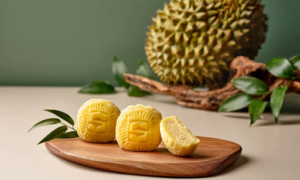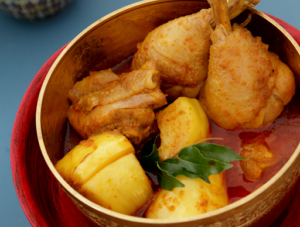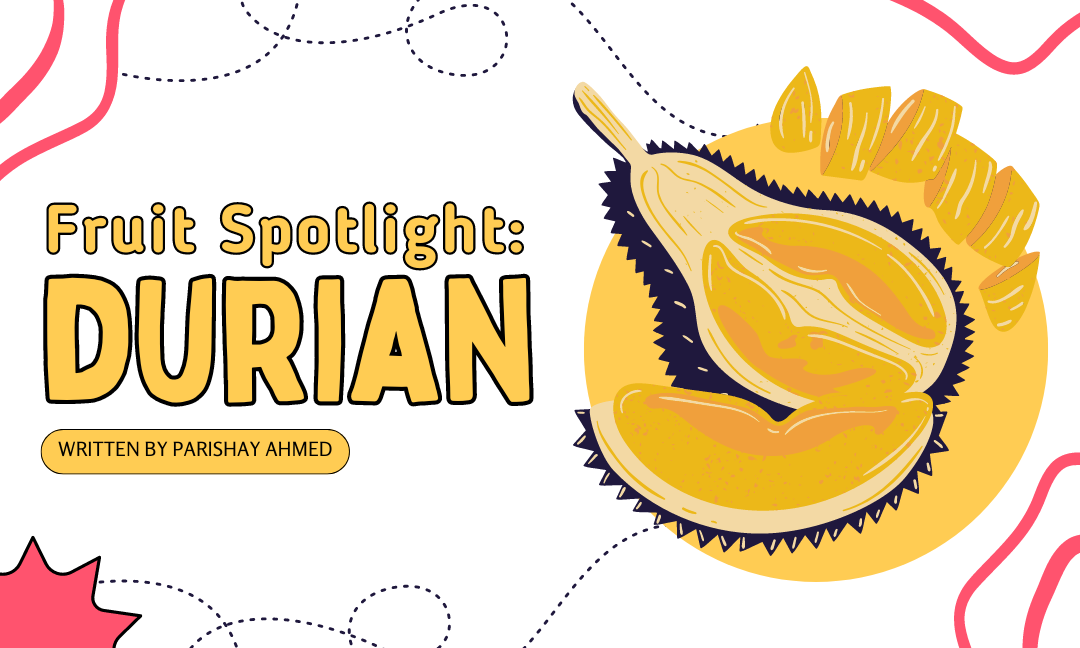Written by: Parishay
Edited by: Rayna Almas
Designed by: Rishona Fernandes
Published by: Maryam Khan
Fruit Spotlight: Durian
Introduction: This Article will cover the many aspects of the fruit Durian.
What is Durian: The durian, a huge, spiky tropical fruit native to Southeast Asia, is referred to as “the king of fruit.”
The thick, spiky husk of durian varies in hue from dull green to a subtle yellow-brown. Its soft, custard-like pulp, which can be either white or golden-yellow, is its edible inside. It is contained within two or three sizable, chestnut-brown seeds found in many pods within a section of the fruit.
Country of Origin: Durian is a native fruit of Southeast Asia. It’s found in Malaysia, Indonesia, and the island of borneo.
It is widely acknowledged that the genus Durio originated in Borneo and that this island served as its original center of diversification.

According to reports, Durio is home to roughly 27 identified species. There are 19 indigenous or native Durio species on the island of Borneo and just 7 native species on the island of Sumatra. There are 11 species in Peninsular Malaysia. There are two identified native species in Myanmar. A pleistocene land bridge between Palawan, Philippines, and Borneo was also theorized, given that D. zibethinus L. was naturally prevalent on Mindanao, the Sulu archipelago, and Palawan.
How is it cooked:
The durian fruit, renowned for its pungent aroma and distinctive taste, is a tropical favorite, especially cherished in Southeast Asia, including Thailand, Malaysia, Indonesia, and the Philippines. Here are some popular ways to enjoy and incorporate durian into culinary delights:
- Fresh Consumption: A common method involves slicing open the spiky outer shell to reveal the custard-like flesh inside. Typically eaten raw, most people scoop out the flesh with a spoon, relishing its rich and creamy texture alongside its singular flavor, which, while adored by some, might deter others due to its intense fragrance.
- Dessert Delights: Durian frequently stars in Southeast Asian desserts, gracing creations like ice cream, cakes, candies, and pastries. Its velvety consistency and bold taste perfectly complement sweet confections. In Malaysia durians are used to make mooncakes and are exported all throughout Asia.
- Smoothies and Shakes: Blending durian into smoothies or milkshakes offers a refreshing and flavorful beverage. Combining durian with milk or coconut milk, ice, and sugar yields a lusciously creamy treat.

- Pancakes or Crepes: Durian’s sweet and creamy flesh serves as a delectable filling for pancakes or crepes, lending a unique twist to breakfast or dessert options.
- Sticky Rice Pairing: In Thailand, durian occasionally joins forces with sticky rice to create a sweet and savory dessert appreciated by locals and visitors alike.
- Candy Creations: Durian-flavored candies provide a convenient means to relish the fruit’s essence without handling the fresh produce directly.

- Savory Creations: Some cuisines incorporate durian into savory dishes. For instance, Malaysian cuisine may feature durian cooked with prawns or infused into curries, imparting a distinctive flavor to the fare. In malaysia a popular dish using Durian is Chicken and Durian curry. This recipe presents a fascinating fusion of chicken and durian curry. Once cooked, the durian takes on a texture similar to that of cooked potato.
Although its culinary potential is vast, the strong aroma of durian can discourage some people, resulting in its prohibition in certain public areas throughout Southeast Asia. Nonetheless, many durian enthusiasts believe its unmatched taste justifies overcoming the initial scent hurdle.
Cultural Significance: In Southeast Asia, durian is an essential part of social and culinary traditions and is revered in the realm of culture. Known as ‘King of Fruits’ reflects its regal position among indigenous fruits. In the region, durian consumption is customary in both ceremonial and everyday contexts.
Festivals: Harvest celebrations with a durian theme take place. There are festivals that take place all over southeast asia. Tenom Durian Festival in Malaysia and the Tagum City Durian Festival in the Philippines particularly memorable. “They’ll have live music, farmer competitions, tastings, and various cooking events,” she explains. “I attended one where they held a durian eating contest with participants having their hands tied behind their backs.”
For attendees, these festivals provide an opportunity to unwind and express their passion for the fruit. “During my time at Fujitsu in Malaysia, I organized annual durian festivals for the company,” shares Tai Chong Poh, a durian farmer in Malaysia. “It was the ultimate team-building activity for our employees.” Today, Poh owns a 9-acre farm in Pahang with 600 durian trees.
In Hong Kong, specialized durian buffets like Durian BB cater to enthusiasts. “At our all-you-can-eat gatherings, Musang King durians steal the show,” says KK Yuen, a partner at Durian BB. Musang King, hailing from the Raub District in Pahang, Malaysia, is renowned for its creamy texture and buttery flavor. Popularized by the late Macao tycoon Stanley Ho, Musang King is an international favorite, especially among the Chinese.
DurianBB charges $90 per person for a buffet session, roughly equivalent to the retail price of one Musang King in China. “Participants can indulge limitlessly for two hours, all for the price of one durian,” Yuen notes. Established in 2012, the company has expanded across Asia, hosting approximately 300 durian buffets and serving over 30,000 attendees. Initially slow, sales for the first buffet eventually soared, resembling the frenzy around new tech releases.
For those seeking more intimate durian experiences, specialty tours, resorts, and farm stays are available, primarily in Malaysia and Thailand, where activities revolve around durian tasting and farm tours.
When given as presents, durians stand for hospitality and respect.
Every nation has a distinct relationship with the durian, which reflects the fruit’s enduring significance
Indonesia: Incorporated into regional cooking customs and frequently utilized in celebratory cuisine.
Malaysia: Uses durian in both savory and sweet dishes.
Thailand: Encourages the development of novel durian products for both domestic and international markets.
Singapore and Vietnam: Durian is regarded as a decadent delicacy that is frequently eaten raw.
The durian’s enduring influence is evidenced by its continued growth and persistence over centuries in Southeast Asian society.
Bibliography:
“Unveiling the King of Fruits: Exploring the Unique Flavors and Cultural Significance of Durian.” Discover Real Food in Texas, Texas Real Fruit, discover.texasrealfood.com/strange-eats/durian-1#:~:text=In%20Southeast%20Asia%2C%20durian%20holds. Accessed 20 June 2024.
Banerjee, Priyanka. Borneo Island: A Guide to the Malay Archipelago of Jungles, Beaches, and Rainforests! 9 Mar. 2019, traveltriangle.com/blog/borneo-island/.
“Chicken and Durian Curry.” Kuali, www.kuali.com/recipe/curry/chicken-and-durian-curry/. Accessed 20 June 2024.
“What Is Durian?” Food Network, www.foodnetwork.com/how-to/packages/food-network-essentials/what-is-durian#:~:text=Known%20as%20%E2%80%9Cthe%20king%20of.
“Durian Festivals.” Www.durianhaven.com, www.durianhaven.com/durian-festivals.htm.

